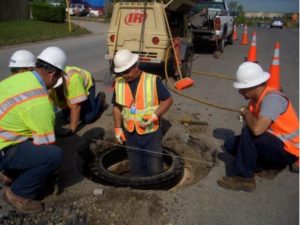Why Solving the Inflow & Infiltration (I&I) Problem Requires a Change in Thinking

Albert Einstein famously said, “Insanity is doing the same thing over and over and expecting different results.” The unwillingness to change can lead to undesirable and unnecessary outcomes time and again. Take the inflow & infiltration (I&I) problem faced by municipalities, for instance.
It’s well known that up to 50% of I&I occurs through the chimney of the manhole. Most cities have concrete manhole rings that fail for a variety of reasons:
- Point load failures due to rocks used to adjust grade
- Deterioration due to heavy traffic
- Dissolving of concrete caused by hydrogen sulfide gas (H2S)
- Crumbling mortar
The typical lifespan of concrete manholes tops out at 25 years but can be as short as 3 years. Recurring inflow & infiltration lead to high expenses to not only treat contaminated water but also repair damaged infrastructure.
Still, many municipalities continually attempt to remedy the issue with the same short-term solutions they’ve always implemented. The result is an endless cycle of failures, I&I surges and repairs.
Why do cities get stuck in this cycle? Isn’t there a different solution to combat inflow & infiltration? These are the questions this article will address.
Stuck in the I&I Rut
Many municipalities aren’t interested in deviating from the norm. Why the resistance to change? In general, continuing to address inflow & infiltration the same way regardless of the level of effectiveness boils down to two reasons:
- Time & effort required to find a different solution
- Uncertainty about costs and ROI
The unwillingness to make a change means that when a manhole fails, a “Band-Aid” is applied, so to speak. The failed concrete rings are simply replaced with different concrete rings.
But this doesn’t really solve the problem. It just bridges the gap from one issue to the next. When this is the approach, just think of the ongoing expenses associated with recurring I&I, repair supplies, installation and manpower.
A Long-Term Solution to Prevent Inflow & Infiltration
Change can be difficult and requires an adjustment period but shouldn’t be viewed as a bad word. If a city is willing to consider a change to its manhole systems, there are technologies that hold up over the long haul.
One such technology is Ladtech’s HDPE manhole adjusting rings. Ladtech products eliminate the problems associated with concrete, brick and rubber manhole rings. Benefits include:
- Mortarless, watertight assembly
- Corrosion-proof construction
- Lifespan of 50-100 years
- Easy installation and precision fit for a range of slopes and sizes
- Made in the USA from 100% recycled HDPE
Specifiers of the Ladtech system have praised its easy installation, effectiveness at preventing I&I and zero repair work. Learn more by reading about projects in Revere, Massachusetts and Apple Valley, Minnesota.
If inflow & infiltration are ongoing problems and existing manhole fixes don’t last, a change in approach is necessary. Specifying a new system can make a difference you didn’t know was possible. To contact Ladtech and request more information, click here.

